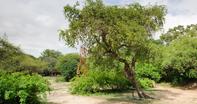
Name
Buffalo Thorn (Ziziphus mucronata)Description
The buffalo thorn blooms from October to April, showing its silvery green flowers hiding in dense bunches of its leaves. Its leaves, too, are silvery-grey, which gave it the Afrikaans name blinkblaar, meaning ‘shiny leaf’. It carries fruits from February to August.
The bark of this tree is a dark grey to brown in colour and has a rough texture. The buffalo thorn is a deciduous tree, meaning it sheds its leaves annually. It grows quickly – up to 17 m tall - and is resistant to extreme weather conditions. Its thorns grow in pairs with one thorn being straight and the other hooked, and at times the tree can lose them entirely.
Its complex thorn system make the buffalo thorn tree an effective perimeter barrier. The flowers and fruit attract a variety of insects and birds, which eat the large red berries.
Uses
The bark and leaves of the buffalo tree are used as treatment to skin infections, pain relief and respiratory problems, particularly for stomach and chest illnesses. Crushed leaves are used to stop bleeding. Some tribes place its branches on the graves of dead tribal members, or use it as protection of cattle kraals and as protection against lightning. The wood is used as firewood and to make implements.Where they are found
The buffalo thorn is widespread from the Western Cape in South Africa to Ethiopia and Arabia.Field Notes
The buffalo thorn is an important element in the beliefs of many African cultures. The Zulu people use the branch of the buffalo tree to bring the spirit of the deceased from the person’s place of death to their burial site. When travelling in a vehicle, the branch will have its own seat.
In Botswana people believe the tree to serve as protection against lightning. It is also known as the blinkblaar wag-‘n-bietjie meaning ‘shiny leaf wait a while’. Its name refers to the difficulty of removing the complex thorns, once hooked.